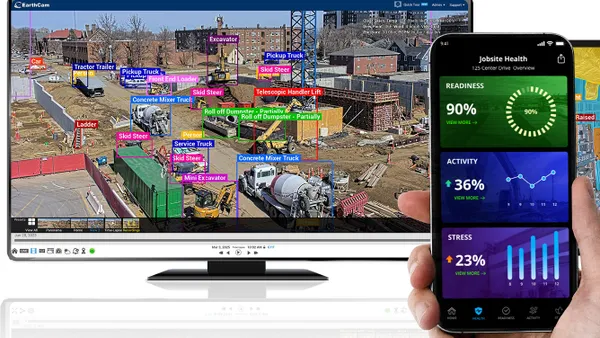Brian Poage is construction support manager for project management software maker Raken. Poage, a former construction project manager for WeWork, spoke with Construction Dive about how the coronavirus has led to increased interest in prefabrication, technology tools for better communication among project stakeholders and moving the industry toward paperless jobsites.
CONSTRUCTION DIVE: What is the landscape for offsite fabrication during the coronavirus and how can contractors take advantage of that?
BRIAN POAGE: When I started a decade ago, offsite fabrication and production was really not a huge part of the industry. In the last five years, I've noticed a pretty significant shift from owners down to subcontractors of wanting to leverage the ability to produce and fabricate things offsite to a point where you're really just installing them. That can be anything from preproduction of plumbing, infrastructure, restrooms, things like that.
Contractors are really trying to get more creative, asking "How can I be more efficient onsite and increase my productivity onsite ... while still maintaining a really aggressive schedule?"
Obviously, COVID-19 has completely shifted the way that we can build. CDC and OSHA requirements and social distancing requirements are preventing contractors from being able to throw manpower at a project, which is typically the kind of normal solution if you fall behind schedule. Because of that loss of productivity and loss of efficiency, contractors are really trying to scramble to figure out what we can do to potentially be able to make up some of this lost time.
I think the investment and the interest in prefabrication is going to be incredible in the next five years. As the investment continues and the learning curve continues, we're only going to get better at these things. And I think it's inevitable that moving forward, prefabrication is going to become a very large part of the construction industry.
What are some other challenges that have come out during the pandemic? What tech has helped solve those unexpected problems?
POAGE: Basic communication is a huge issue. One of the fundamental concerns for any construction manager, whether you're working for a general contractor or subcontractor, is just the ability to effectively communicate. Even in a perfect world where we are building at 100 miles an hour with no regulation and no restrictions, there is so much communication that falls through the cracks.
So, let's throw in the fact that now you have limited ability to be on a jobsite. You have project managers and office teams that are working offsite. They're not physically on the jobsite anymore. There's a lot more opportunity for communication to fail.
Utilizing basic communication tools has been really impactful. Instead of the project manager going out and walking the job with my superintendent, we could jump on [a call] at these times. And he or she can even show me areas of the project where we have concerns or where we have some constructability questions, things like that. I can visually then understand what's going on.
Documenting these is probably the most important thing that any subcontractor and general contractor can be doing to protect themselves from future litigation during a time like this. You are delayed because of COVID, and you do not follow the contractual obligations when it comes to effectively communicating that delay to ownership if you have shut down for a week because of COVID. Then, months from now, you explain to them that the project needs to be pushed out because of that delay. If you didn't follow the proper channels of communication, the owner's going to say "No way. I don't owe you anything because you didn't follow the contractual agreement."
Documenting things in writing, communicating them effectively up the chain and providing sorts of visuals ... will help contractors protect themselves down the road.
What is going to be different about the construction tech landscape in the future?
POAGE: I think you're going to see entirely paperless jobsites. There's nothing inherently wrong with paper. It's just that you can be more efficient by leveraging tools and even from purely an exposure standpoint: Paper requires physical contact. Figuring out ways to take common workflows that exist in the industry that currently require paper and making them electronic is going to be a really big one.













